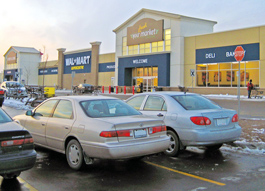home | north bay bohemian index | news | north bay | news article

PRODUCE, DELI, BAKERY, WELCOME: Wal-Mart plans to open a supercenter in every California county similar to this one in Canada.
Building a Bigger Box
Wal-Mart's proposed Rohnert Park expansion is just part of the usual plan, says UC history professor
By Kylie Mendonca
Nelson Lichtenstein can sound like someone with important news to share when he starts talking about Wal-Mart's contributions to the American and global business worlds. Not one for a pregnant pause or lulls in conversation, Lichtenstein moves seamlessly between his thoughts, fast as they come. For all his excitement over the mega-retailer, Lichtenstein is not singing the praises of cheap products and cheaper labor.
This University of California Santa Barbara history professor, as they say, "wrote the book" on Wal-Mart—literally—penning some 300 pages of history, criticism and personal journey on the company ranging from its sweatshops in China to its corporate home in Arkansas. Lichtenstein will speak and sign copies of his new book, The Retail Revolution: How Wal-Mart Created a Brave New World of Business, on Jan. 22 in Santa Rosa.
His arrival has local resonance. In the coming weeks, Rohnert Park city officials will be talking about Wal-Mart, too. The proposed 24-hour Wal-Mart supercenter project will go before the planning commission for review this winter, a proposal to expand the city's current Wal-Mart into a full grocery store. The only other such supercenter in the North Bay is located in American Canyon, though the company is said to have plans to construct one in each California county. Locally owned grocers are concerned, and opposition in Napa County stalled the American Canyon project for three years before it was finally approved.
Under the current proposal, the shopping center could grow by more than 40,000 square feet, ballooning from its current 131,532-square-foot footprint to almost 171,800 square feet. According to the environmental impact report, finalized Jan. 15, the space will bring locals new job opportunities, new shopping convenience—and plenty of new traffic congestion, too.
While neighbors worry that the expansion could put local grocery stores out of business, Lichtenstein focuses on the ripples left by the retailer across the global business landscape. The problem with Wal-Mart, he argues, is not so much found in the trail of small-town retail wreckage it leaves but in the example it sets for other major retailers and their employees. Wal-Mart is less important as a Wal-Mart, Lichtenstein says, "than it is important for what it teaches."
The Wal-Mart model, Lichtenstein says, is low prices bought on the backs of workers. Sure, the consumer saves a buck, but that buck has to come from somewhere, and Lichtenstein argues it comes from the workers in the form of lower wages, scanty benefits and minimal job security. "In general," Lichtenstein says, "they are pulling down the wage level for millions of people"
For Lichtenstein, this trend was underscored some five years ago when a group of grocery store workers in Southern California held massive demonstrations against their corporate bosses. In response to market pressures, he writes, corporations such as Safeway and others asked workers to take pay cuts. The unions, of course, were not keen. Lichtenstein identified this request as a sort of "Wal-Mart effect."
Several local business groups have latched on to Lichtenstein's message. The Living Wage Coalition on Sonoma County, Go Local Sonoma County and the North Bay Labor Council, are among the groups sponsoring Lichtenstein's upcoming talk.
Martin Bennett, co-chair of the Living Wage Coalition of Sonoma County, is among those who oppose the proposed expansion. "The decision by the Rohnert Park city council will be closely watched and, if affirmative, highly controversial, particularly given the rejection by the Santa Rosa city council of a proposed Lowe's Home Improvement store earlier this year," he says. For Bennett, the construction of a supercenter is about more than low wages and what some see as unfair grocery store competition. In addition to an EIR, the Living Wage Coalition consistently seeks community impact reports for such large businesses, looking to measure how the overall quality of life is affected when a big-box retailer comes into town or, as in this case, grows even bigger.
In 2006, Wal-Mart approached the city of Santa Rosa to take over an idle lot in the unincorporated southwest part of town. The corporation finally dropped efforts to build last February after activist groups successfully pressed a lawsuit against the corporation over its environmental impact report. The store's loss meant a half a million dollar estimated loss in Santa Rosa sales tax revenue.
But being sued is part of the Wal-Mart story, according to Lichtenstein. He writes: "When Wal-Mart locates one of its grocery-selling supercenters in metropolitan America, it asserts the legitimacy and power of a brand of capitalism that is antithetical to the regulated marketplace. . . . The company is therefore constantly defending itself against a set of class-action lawsuits." In other words, it's par for the course.
Nelson Lichtenstein appears at Copperfield's Books on Friday, Jan. 22, at 7pm. 2316 Montgomery Drive, Santa Rosa. Free. 707.578.8938.
Send a letter to the editor about this story.
|
|
|
|
|
|